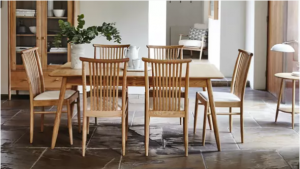Beginner’s Guide To Wood Veneers: Paper Backed, Wood Backed, Peel and Stick
Wood Veneers: Paper Backed, Wood Backed, Peel and Stick
Today I’m going to Introduce about paper backed veneers, wood backed veneers, and peel and stick veneers.
Most of the types of veneers that we sell are:
- 1/64″ Paper Backed
- 3/64″ Wood Backed
- Both of the above can be ordered with 3M peel and stick adhesive
- Sizes range from 2′ x 2′ up to 4′ x 8′ – Sometimes larger
1/64″ Paper Backed Veneers
The paper backed veneers are thin and flexible, especially when you bend them with the grain. This bendability might come in real handy if you are trying to bend your veneer around a corner or if you have a concave or convex surface that you are working with.
The paper backer is a tough, strong, 10 mil paper back that is permanently bonded to the wood veneer. Of course, the paper side is the side that you glue down. You can use woodworker’s glue or contact cement to glue the paper backed veneers down. The paper backed veneers can also be ordered with the optional 3M peel and stick adhesive.
You can cut the paper backed veneers with a utility knife or a scissors. For most surfaces, you cut the veneer larger than the area that you are going to veneer. Then you glue the veneer down and you trim around the edges with a razor knife to get an exact fit.
3/64″ Wood Backed Veneers
The 3/64” wood backed veneer is also called “2 ply veneer” because it is made using 2 sheets of veneer that are glued back to back. It would be correct to call it “2 ply veneer”, “wood backed veneer” or “2 ply wood backed veneer”.
The only differences between the 1/64” paper backed veneers and the 3/64” wood backed veneers are the thickness, and of course, the type of back. The extra thickness of the wood backed veneers, coupled with the wood construction of the back, give added strength and stability as compared to the paper backed veneers.
The wood backed veneers, just like the paper backed veneers, can be cut with a razor knife, and even a scissors. And, just like the paper backed veneers, the wood backed veneers also come with an optional 3M peel and stick adhesive.
Paper Backed Veneer Or Wood Backed Veneer – Pros And Cons
So, which is better – paper backed veneer or wood backed veneer? Actually, you can usually use either one for most projects. In some situations, such as when you have a curved surface, the paper backed veneer may be your best choice.
Sometimes wood backed veneer is the only way to go – and this would be when you need the extra thickness to reduce any telegraphing through the veneer from an uneven surface, or from an uneven application of contact cement. – Or, perhaps for a table top or a surface that gets a lot of wear and tear.
If you use contact cement for your adhesive, some types of finishes, such as lacquer, especially if thinned down and sprayed, might soak through a paper backed veneer and attack the contact cement. This doesn’t happen often, but if you want an added margin of safety, the added thickness of the wood backed veneer will prevent any seepage of the finish to the glue layer.
Our customers use both the paper backed and the wood backed veneers with success. Some of our customers use the paper backed veneers exclusively and some customers prefer the wood backed veneers.
I prefer the wood backed veneers. They are sturdier, flatter, easier to use, and more forgiving. They eliminate problems with seep through of finishes and they reduce or eliminate the telegraphing of defects that might be present on the substrate. Overall, I think that the wood backed veneers give an added margin of safety, even when the craftsman makes some mistakes.
Sanding And Finishing
All of our paper backed veneers and wood backed veneers are pre sanded at our factory, so sanding isn’t usually necessary. For finishing, you apply a stain or a finish to our wood veneers the same way that you apply a stain or a finish to any wooden surface.
If you use contact cement to glue our paper backed veneers down, be aware that some oil based finishes and stains and particularly lacquer finishes, especially if thinned down and sprayed, might seep through the veneer and attack the contact cement. This isn’t usually a problem but it can happen. If you use the wood backed veneers, this isn’t a problem, as the thickness and the wooden back prevents this.
Optional 3M Peel and Stick Adhesive
As for the peel and stick adhesive – I really like it. We use only the best 3M adhesive for our peel and stick veneers. The 3M peel and stick veneers really do stick. You just peel off the release paper and stick the veneer down! The 3M peel and stick veneers lay down real flat, real easy and real fast. We’ve been selling the 3M peel and stick veneers since 1974 and our customers love them. There is no mess, no fumes and no clean up.
I hope that this tutorial has been helpful. Check out our other tutorials and videos for more instructions about wood veneers and veneering techniques.
- PAPER BACKED VENEER SHEETS
- WOOD VENEER SHEETS
- PSA VENEER
Post time: Jul-05-2022



